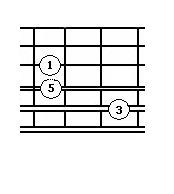Originally Posted by: jluther0516I am just really confused as to why these voicings are labeled as "D", "E", and "G".[/quote]Because they are first inversion voicings with an embellishment.
Originally Posted by: jluther0516How on earth is this a D chord? Wouldn't it be an "E" chord since the root note is the 7th fret of the A string? What am I missing here?
The E note is the 2nd degree of the D major scale & is merely an embellishment that happens right before you hammer-on the F#, the major 3rd of the D major scale.
So you get these scale degrees.
|-----------------------------------|
|-----------------------------------|
|--7-(d)(1st)---7-(d)(1st)-----|
|--7-(a)(5th)---7-(a)(5th)-----|
|--7-(e)(2nd)--9-(f#)(3rd)----|
|-----------------------------------|
To be precise, the first chord is a Dsus2, then after the hammer-on you have a resolution to a complete D major chord in first inversion (or D/F#). Important to notice is that the root note doesn't have to be the lowest note in a chord voicing.
This is a commonly used technique in rock music, and the 2nd to 3rd hammer-on happens so quickly that it's just regarded as a grace note embellishment of the D chord.
Same for the other chords. You're playing a commonly used first inversion rock chord voicing. See tunes by Hendrix, The Stones, Skynyrd & others.

That image is from my series of tutorials on chord voicings.
https://www.guitartricks.com/collection/triads-and-inversions
You might enjoy just working through this one tutorial on how any chord can be played in a variety of ways across the fretboard.
https://www.guitartricks.com/tutorial.php?input=148
[quote=jluther0516]Is the "voicing" the fact that the "barre" has been removed from fret the fifth frets on ADGBE?
[p]Good question. The term voicing simply means how & where the notes of a chord are played. So, it's related to the possibility of barring at the 5th fret, but doesn't only mean that.
Any place on the guitar you can find to play the notes D, F# and A together make a voicing of a D major chord.
But being able to visualize that barre chord voicing is a great way to help work toward other voicings because you can see all the notes of the scale around that shape & extrapolate other possible related voicings.
Hope that helps!
Christopher Schlegel
Guitar Tricks InstructorChristopher Schlegel Lesson Directory
